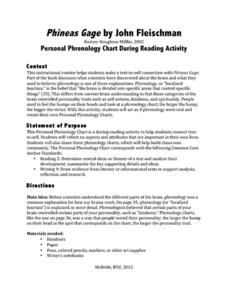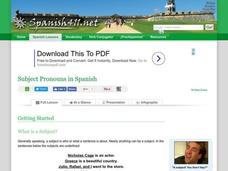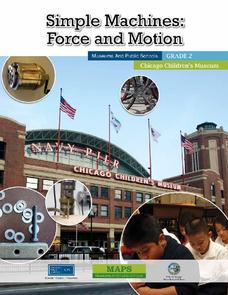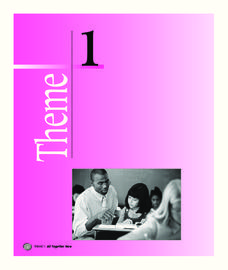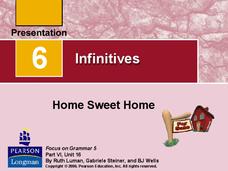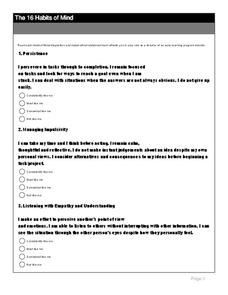BBC
Sound and Hearing
First and second graders recognize that sound is generated in a variety of ways, and that it comes from many different sources. They explore tone and volume, realizing that there are different ways to describe sound. Some musical...
Curated OER
Nureyev: After Petipa
Incorporating the arts into regular classroom practices isn't an easy task. Learners will research background information regarding Russian culture, history, and conflict then see how those things have applied to the rigors of Russian...
Curated OER
What Can I Do?
Students investigate conflict resolution strategies. In this character education lesson, students list things that make them feel sad and are introduced to the conflict resolution strategy "think and share." Students role-play various...
Curated OER
"Snapshot" Exercises & Sensory Detail Word Bank
Read a sample of creative descriptive writing to your science class. Discuss how writing can be used to record and communicate observations that scientists make. Reading selections and thought-provoking questions are suggested. Also...
Curated OER
Fun Physics You Can See
Fascinating aspects of electromagnetic radiation and its use in obtaining and transferring information are described here. Learners will find the connections to current technology interesting. Although the slides are text-heavy, they do...
Curated OER
The Celts
Look far back in history and you'll meet a people group called the Celts. Celts, as you'll soon find out, are a group of people who inhabited Britain 2000 years ago. Presented here, is simple information which describes a bit about...
Curated OER
What if Your Parent Ran for President?
Throughout history, many people have run for president. But, what is that like for the children of those individuals? Kids read a bit about Mitt Romney and his five children, then respond to a writing prompt in a blog post. They describe...
Curated OER
Make Up Your Story
Putting together an interesting story can be hard, but this set of worksheets will guide your writers into the depths of their own creativity as they characterize both their main character and villain. Using humor to keep learners...
Curated OER
Could Have, Should Have, Would Have
Could have, should have, would have learned your auxiliary verbs! Use this resource to describe the meaning of each set of words, and then let your kids try to complete the given sentences. Since most people don't actually take the time...
Curated OER
Phineas Gage: Personal Phrenology Chart During Reading Activity
Phrenology, the belief that parts of your brain control certain aspects of your personality, is described in Phineas Gage: A Gruesome but True Story About Brain Science. While we now know much more about the brain, learners use this...
EngageNY
Writing a First Draft: Accessing Books Around the World Informative Paragraph
Supervise the final drafting of a well-organized paragraph by following the steps outlined in this plan. Using the included sample paragraph as a model, class members brainstorm criteria for quality work and then compose their paragraphs...
Curated OER
Subject Pronouns in Spanish
Starting off with examples and explanations of English subjects and pronouns, this resource explores Spanish subject pronouns in great detail. Each subject pronoun is described and paired with examples. Additionally, the material...
TED-Ed
What is the World Wide Web?
Did you know that the World Wide Web and the Internet are not the same thing? Did you know that Tim Berners-Lee is considered the father of the Web? Networks, web servers, web hosts, website addresses, domain names, web languages,...
National Gallery of Canada
My World
Art can tell viewers about an artist's personality and background. Have your learners look at Inuit art and consider subject matter and how it relates to the artist and his or her world. The related art project requires pupils to create...
Chicago Children's Museum
Simple Machines: Force and Motion
Get things moving with this elementary science unit on simple machines. Through a series of nine lessons including teacher demonstrations, hands-on activities, and science experiments, young scientists learn about forces, motion,...
Avi Writer
City of Orphans: Teaching Guide
"Amazing things happen" in Avi's City of Orphans, and the suggestions in this teacher's resource will guide readers through through the many stories of the different characters living in the tenements of 1893 New York.
Houghton Mifflin Harcourt
All Together Now: Challenge Activities (Theme 1)
For scholars who need a challenge in the classroom, here is a unit for you. Learners explore topics such as animals, sports, helpers at home, the past, and funny things that have happened in their lives. Youngsters also engage...
KOG Ranger Program
Match and Lighter Safety
Go over the basics of fire prevention with a lesson plan focused on safety with matches and lighters. With a series of dilemma cards that describe potential fire risks, learners choose the most responsible way to handle matches and...
Pearson
Infinitives
If you want to buy a house, what's the first thing you need to do? Learn about buying a home, and about infinitive phrases, with a helpful and straightforward slideshow presentation.
Center School
The 16 Habits of Mind
Which of Costa's 16 Habit of Mind best describes you? Take a short assessment to see which quality is most consistently like you, or which quality is not like you at all.
Houghton Mifflin Harcourt
Nature Walk: English Language Development Lessons (Theme 2)
Walking in nature is the theme of a unit designed to support English language development lessons. Scholars look, write, speak, and move to explore topics such as camping, woodland animals, instruments,...
Computer Science Unplugged
Marching Orders—Programming Languages
Computers need precise directions to complete a task. Class members experience what it is like to program a computer with an activity that asks one pupil to describe an image while classmates follow the directions to duplicate the picture.
EngageNY
Perimeter and Area of Polygonal Regions Defined by Systems of Inequalities
When algebra and geometry get together, good things happen! Given a system of inequalities that create a quadrilateral, learners graph and find vertices. They then use the vertices and Green's Theorem to find the area and perimeter of...
Willow Tree
Patterns - Numbers, Shapes, etc.
Find the pattern is the name of the game! Learners examine different patterns represented by numbers, shapes, and words. They must describe the pattern, predict the result in a given position, and find an equation that...









